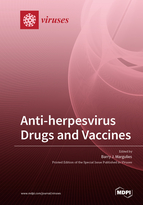Anti-herpesvirus Drugs and Vaccines
A special issue of Viruses (ISSN 1999-4915). This special issue belongs to the section "Viral Immunology, Vaccines, and Antivirals".
Deadline for manuscript submissions: closed (28 February 2022) | Viewed by 44436
Special Issue Editor
Special Issue Information
Dear Colleagues,
Since the advent of trifluridine and idoxuridine, the antimicrobial community has been looking for better, more specific drugs and vaccines to both prevent and suppress infections of herpesviruses. The greatest active pharmaceutical ingredient since then has been acyclovir and its derivatives; the greatest vaccine successes against a human herpesvirus have been against varicella zoster virus. However, antiherpetic drug and vaccine discovery continues today, especially with the more recent clinical licensing of drugs such as letermovir and animamevir and vaccines such as Shingrix.
This Special Issue takes a look at both current antiherpetic interventions available today, with medications and vaccines used to act prophylactically and therapeutically, and where the field is moving in the near future. We also explore newer ideas for long-term suppression and perhaps even removal of latent virus.
Prof. Dr. Barry J. Margulies
Guest Editor
Manuscript Submission Information
Manuscripts should be submitted online at www.mdpi.com by registering and logging in to this website. Once you are registered, click here to go to the submission form. Manuscripts can be submitted until the deadline. All submissions that pass pre-check are peer-reviewed. Accepted papers will be published continuously in the journal (as soon as accepted) and will be listed together on the special issue website. Research articles, review articles as well as short communications are invited. For planned papers, a title and short abstract (about 100 words) can be sent to the Editorial Office for announcement on this website.
Submitted manuscripts should not have been published previously, nor be under consideration for publication elsewhere (except conference proceedings papers). All manuscripts are thoroughly refereed through a single-blind peer-review process. A guide for authors and other relevant information for submission of manuscripts is available on the Instructions for Authors page. Viruses is an international peer-reviewed open access monthly journal published by MDPI.
Please visit the Instructions for Authors page before submitting a manuscript. The Article Processing Charge (APC) for publication in this open access journal is 2600 CHF (Swiss Francs). Submitted papers should be well formatted and use good English. Authors may use MDPI's English editing service prior to publication or during author revisions.
Keywords
- antiviral chemotherapy
- acyclovir
- aciclovir
- ganciclovir
- valtrex
- antiherpetic
- varivax
- zostavax
- oka
- herpes vaccine
- Marek’s Disease Virus
- veterinary herpes
- rhinopneumonitis
- pneumabort-K
- cytovene
- letermovir
- maribavir
- amenalief







